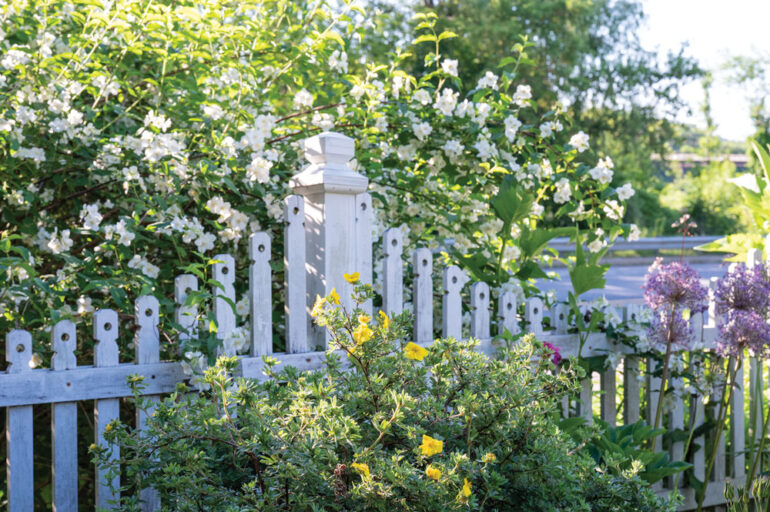By Virginia M. Wright
Photos by Kelsey Kobik
From our June 2025 issue
Ellen Jackson lives on a busy road in Farmingdale, but her home seems to float above the din, tucked behind a curtain of lilac, mock orange, and sour-cherry blossoms. Like many first-time visitors, I breezed past her driveway, realizing I missed it when I caught a flash of white picket fence between the flower-laden branches. Circling back and turning in, I was awed by the sight of thousands of blooms framing an oval lawn: pink peonies, orange poppies, huge purple and tiny true-blue alliums, lavender wisterias, and more.
Jackson has spent nearly 30 years growing this half-acre Eden. It has demanded patience, she explained as she showed me around. For each new bed she dug and planted, she first had to convert the thick, goopy marine clay into hospitable soil, a two- to three-year process of sowing and tilling cover crops like buckwheat and winter rye. Such work comes naturally to her. She’s been gardening since she was a child growing up in central Florida. “My dad got me into it,” she recalled. “He took me to a lot of gardens, and we were growing boxwoods from little cuttings when I was nine.”
When Jackson bought her home, in 1998, the lawn descended gently to a low granite retaining wall by the sidewalk. There were no flowerbeds, just a bunch of yews along the front of the house, a 1950 Cape built for a member of the Hazzard family, owners of a shoe factory that was once one of the area’s largest employers. She tackled the yews first, removing them and installing a border that produces a rainbow of colors: fiery scarlet crocosmias, pink ground orchids, blue peach-leaved bellflowers, bronze euphorbias, pale-pink gas plants, and lemon-yellow and tangerine globe flowers. A Miss Kim lilac and an impressive dome-shaped Japanese maple anchor each corner.
A few years after she moved in, Jackson seized an opportunity to rethink her landscape when a portion of the retaining wall collapsed. She had the wall dismantled and rebuilt several feet back from the sidewalk, which leveled the lot and created a terrace for a picket fence and living privacy screen, including a peach tree, potentilla, and creeping larch. These form the backdrop to a curving bed lined with reclaimed cobblestones and populated with rose campions, yuccas, and a large, stately inula that, come August, sprouts long spikes of yellow daisy-like flowers. On the other side of the wall, between its base and the sidewalk, are Pink Charm peonies, Wine & Roses weigelas, false indigos, Crispa incisa, and the aforementioned lilac, sour cherry, and mock orange.
Most of Jackson’s perennials are divisions of plants transplanted from her former home in Dixmont or bought at nurseries. Her practice of walking through the beds and shaking the ripe seed pods of columbines, Drumstick and Schubertii alliums, and other favorites lends both harmony and informality to the garden she created by adding one bed at a time to the lawn’s perimeter. That circle complete, she now expands by generously edging beds to redefine their shape and depth. Stopping in front of a section of freshly turned soil, she said, “I was digging here the other day, and my boyfriend asked what I was doing. I told him I needed more space for plants. He looked around and said, ‘Are you kidding me?’”










